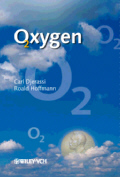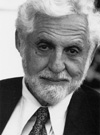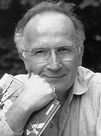

This year marks the one-hundredth anniversary of the awarding of Nobel Prizes by the Nobel Foundation. Imagine that to mark this centennial, the foundation decides to award a "retro-Nobel Prize" for those great discoveries in chemistry that occurred before the first prize was given. The task of making this award is the context of the play Oxygen, which had its world premiere April 2, 2001 at the San Diego Repertory Theater. This date coincided with the opening of the 125th national meeting of the American Chemical Society in San Diego, and the audience was packed with members of that field. Oxygen was written by two world-famous chemists, Carl Djerassi of Stanford University and Roald Hoffmann of Cornell University; both have increasingly pursued literary work after receiving almost all the accolades possible in their respective research fields. The play concentrates on finding the first retro-Nobel in chemistry.
a "retro-Nobel Prize" for those great discoveries in chemistry that occurred before the first prize was given. The task of making this award is the context of the play Oxygen, which had its world premiere April 2, 2001 at the San Diego Repertory Theater. This date coincided with the opening of the 125th national meeting of the American Chemical Society in San Diego, and the audience was packed with members of that field. Oxygen was written by two world-famous chemists, Carl Djerassi of Stanford University and Roald Hoffmann of Cornell University; both have increasingly pursued literary work after receiving almost all the accolades possible in their respective research fields. The play concentrates on finding the first retro-Nobel in chemistry.
Of course, many choices are possible for this great honor. One candidate that springs to my mind is Amedeo Avogadro (1776-1856), who in 1811 put forward the hypothesis that equal volumes of gas at the same temperature and pressure contain equal numbers of atoms or molecules. Indeed, Avogadro first coined the word "molecule" and introduced the concept that substances could be polyatomic. Another most worthy candidate is Jöns Jacob Berzelius (1779 - 1848), noted for his determination of atomic weights, the development of modern chemical symbols, his electrochemical theory, the discovery and isolation of several elements, the development of classical analytical techniques, and his investigations of isomerism and catalysis (both named by him). But then you would not have a play! Instead, the retro-Nobel committee struggles with making the award for the discovery of oxygen. There are three contenders. The first is Carl Wilhelm Scheele (1742-86), the Swedish apothecary who is the first to discover "fire-air" but fails to publish this discovery until 1777. The second is Joseph Priestley (1733-1804), the English Unitarian minister who discovers oxygen but clings dogmatically to the theory of phlogiston, which says that all flammable materials contain an odorless, colorless, weightless substance (phlogiston) that escapes upon burning. Hence, Priestley fails to understand the true significance of what he has found. The third candidate is the French chemist and tax collector Antoine Laurent Lavoisier (1743-94), who was the first to recognize that combustion involved oxidation. By denying the existence of phlogiston, Lavoisier was able to establish the principle of conservation of mass in chemical reactions.
The play skillfully jumps back and forth between the time periods of the 1770s and the present as the Nobel Prize committee grapples with this choice. At first, the task seems to be an easy one, with Lavoisier the first choice as the father of modern chemistry. But the plot thickens when it is revealed that he had the benefit of much knowledge of the work of his competitors. In 1774 Priestley, a guest in Lavoisier's home in Paris, told him how he had made what he called dephlogisticated air. At approximately the same time, Scheele wrote Lavoisier a letter detailing his discovery of fire-air and how to make it. Both Priestley and Scheele believed in phlogiston, but Lavoisier was able to comprehend the true significance of oxygen in combustion. As they say, the rest is history - but do we really know the true story? Djerassi and Hoffmann capture and amplify the moral dilemma of whether Lavoisier gave sufficient credit to those whose work he used to overthrow the theory of phlogiston.
Ask someone what "oxygen" means. To scientists the answer is obvious, and the only clarification needed is an answer to the question, Atomic or molecular? But to many, oxygen has other meanings than simply the life-giving stuff of air. If you doubt this, check this address: http://www.oxygen.com/. You will find a Web site devoted to a woman's view of the world. This site connects you to what is one of the most audacious entertainment start-ups in decades. Oxygen is the first online and on-air network for women by women; it is now on cable TV in the United States. Its slogan is "Another Great Reason to Be a Woman," and its special spokesperson and salesperson is Oprah Winfrey, perhaps the world's best known, most influential, and richest TV personality. Djerassi and Hoffmann's Oxygen plays on this association of the word. Throughout their play, what women have to say takes on more significance than what is said by men.
The chair of the retro-Nobel Prize Committee is Astrid Rosenqvist, an outstanding theoretical chemist who had some past romantic involvement with another committee member, Bengt Hjalmarsson. A lovers' quarrel runs throughout the dialogue. Two other distinguished men complete the committee. Rosenqvist introduces Ulla Zorn, who is supposed to be present only to record the meeting. But Zorn is more than an amanuensis; it unfolds that she is pursuing a doctorate on the role of women in the history of science. As the wrangling over the candidates for the prize intensifies, her role changes, and she tells the men that to select properly among the three contenders it is necessary to ask the women most closely associated with them. We are treated to a steamy scene in a sauna that involves the fictional encounter of the prim 35-year-old Mary Priestley, wife of Joseph Priestley; the 26-year-old Sara Margaretha Pohl, Scheele's devoted housekeeper whom he would marry on his deathbed; and the worldly 19-year-old Marie-Anne Pierrette Pauize Lavoisier, whom Lavoisier married when she was 13. The play argues that these three women were much more than bystanders to the scientific accomplishments of their male partners. For example, did Madame Lavoisier intercept Scheele's letter to her husband and keep it secret from him? In view of the many complications concerning the discovery of oxygen, what was the final choice of the retro-Nobel committee? Djerassi and Hoffmann resolve the conflict brilliantly, but I will not give away the ending.
Having served on and chaired several prize committees, I felt that the carping remarks of the members of the retro-Nobel committee resembled more a faculty appointment process gone terribly awry than the serious deliberations of a prize selection. I asked Sture Forsén of Lund University, a member of the Chemistry Nobel Prize Committee for 19 years, what his impressions were. He agreed with me that the play shows more a caricature than a picture of what transpires in such deliberations. Of course, playwrights are allowed to take liberties, and Oxygen does just that. It provides a most diverting and entertaining evening for chemists and those who ponder the nature of discovery and the attribution of discovery to individuals.
 Carl Djerassi is well known for his work in the synthesis of steroid oral contraceptives and for the development of mass spectrometric techniques. He wrote more than 1200 articles in the area of chemistry before turning to what he calls "science in fiction." He is the author of several novels: Cantor's Dilemma, The Bourbaki Gambit, NO, Marx, Deceased, and Menachem's Seed, as well as a play based on that novel, An Immaculate Misconception. He has also written his memoirs and two autobiographies, Steroids Made It Possible (for chemists) and The Pill, Pygmy Chimps & Degas' Horse (for nonscientists). Awards and honors received by Djerassi include the National Medal of Science in 1973, and the American Chemical Society's highest honor, the Priestley Medal, in 1992.
Carl Djerassi is well known for his work in the synthesis of steroid oral contraceptives and for the development of mass spectrometric techniques. He wrote more than 1200 articles in the area of chemistry before turning to what he calls "science in fiction." He is the author of several novels: Cantor's Dilemma, The Bourbaki Gambit, NO, Marx, Deceased, and Menachem's Seed, as well as a play based on that novel, An Immaculate Misconception. He has also written his memoirs and two autobiographies, Steroids Made It Possible (for chemists) and The Pill, Pygmy Chimps & Degas' Horse (for nonscientists). Awards and honors received by Djerassi include the National Medal of Science in 1973, and the American Chemical Society's highest honor, the Priestley Medal, in 1992.
 Roald Hoffmann won the 1981 Nobel Prize in chemistry for theories concerning the course of chemical reactions. He shared the prize with the late Kenichi Fukui. Hoffmann's literary works include books of poems, The Metamict State (1987) and Gaps and Verges (1990); Chemistry Imagined (1993), a book about art, science, and literature written with the artist Vivian Torrence; The Same and Not the Same (1995), an account of the dualities in chemistry; and Old Wine, New Flasks: Reflections on Science and Jewish Tradition (1997), a book he coauthored in an intertwining of voices of science and religion. He is also a recipient of the National Medal of Science (1983) and the Priestley Medal (1990).
Roald Hoffmann won the 1981 Nobel Prize in chemistry for theories concerning the course of chemical reactions. He shared the prize with the late Kenichi Fukui. Hoffmann's literary works include books of poems, The Metamict State (1987) and Gaps and Verges (1990); Chemistry Imagined (1993), a book about art, science, and literature written with the artist Vivian Torrence; The Same and Not the Same (1995), an account of the dualities in chemistry; and Old Wine, New Flasks: Reflections on Science and Jewish Tradition (1997), a book he coauthored in an intertwining of voices of science and religion. He is also a recipient of the National Medal of Science (1983) and the Priestley Medal (1990).
Science in theater is emerging as an exciting new art form. It can be seen in such plays as Tom Stoppard's Arcadia, which revolves around a 13-year-old math prodigy, Thomasina Coverly, who baffles her tutor by asking if God is a Newtonian, and Michael Frayn's Copenhagen, which is based on the uncertainties surrounding the 1941 meeting between the physicists Niels Bohr and Werner Heisenberg in German-occupied Copenhagen.
We are indebted to Carl Djerassi and Roald Hoffmann for showing the world that chemistry can also be theater. The premiere audience, almost a Who's Who in chemistry, was greatly amused by the play; it remains to be seen whether it will also appeal to a less knowledgeable audience.
© Wiley-VCH 2001